Variable Optimization of Seaweed Spectral Response Characteristics and Species Identification in Gouqi Island
Abstract
1. Introduction
2. Materials and Methods
2.1. Sample Collection
2.2. Sample Preparation
2.3. Statistical Analysis
3. Results
3.1. Spectral Characteristics of Six Species
3.2. Trend Analysis of Seaweed Spectra
3.3. Analysis and Optimal Screening of Spectral Variables of Seaweeds
3.4. Support Vector Machine Classification
3.5. Fusion Model Classification
4. Discussion
5. Conclusions
Author Contributions
Funding
Data Availability Statement
Acknowledgments
Conflicts of Interest
Appendix A
| Spectral Variables | F | F-Crit | p-Value |
|---|---|---|---|
| NDVI (Rg, Rr) | 1394.059 | 2.236 | * |
| NDVI (Are, Abe) | 451.375 | 2.236 | * |
| RVI (Rg, Rr) | 388.796 | 2.236 | * |
| RVI (Are, Abe) | 6.209 | 2.236 | * |
| Vre | 118.014 | 2.236 | * |
| Are | 54.912 | 2.236 | * |
| Lre | 32.664 | 2.236 | * |
| Rr | 37.524 | 2.236 | * |
| Lr | 12.512 | 2.236 | * |
| Vbe | 499.016 | 2.236 | * |
| Abe | 978.548 | 2.236 | * |
| Lbe | 15.985 | 2.236 | * |
| Rg | 164.210 | 2.236 | * |
| Lg | 134.548 | 2.236 | * |
| Spectral Variables | S12 | S13 | S14 | S15 | S16 | S23 | S24 | S25 | S26 | S34 | S35 | S36 | S45 | S46 | S56 |
|---|---|---|---|---|---|---|---|---|---|---|---|---|---|---|---|
| NDVI (Rg, Rr) | * | * | * | * | * | * | * | * | * | * | * | * | * | * | 0.463 |
| NDVI (Are, Abe) | * | 0.897 | * | * | 0.366 | * | * | * | 0.109 | * | * | 1.000 | * | * | * |
| RVI (Rg, Rr) | * | * | * | * | * | * | * | * | * | * | * | * | * | * | 0.511 |
| RVI (Are, Abe) | 0.998 | 1.000 | 0.998 | 0.690 | 0.800 | 0.784 | * | * | 0.951 | * | * | 0.366 | * | * | * |
| Vre | * | * | * | * | * | * | * | * | * | * | * | * | 0.638 | * | * |
| Are | * | * | * | 0.547 | * | 0.181 | * | * | 1.000 | * | * | 0.692 | 0.110 | * | * |
| Lre | * | * | * | * | * | 0.980 | 0.135 | * | * | 0.777 | * | * | * | * | * |
| Rr | * | 0.118 | * | * | * | * | * | 1.000 | * | * | * | * | 0.218 | 0.143 | * |
| Lr | * | 0.143 | * | * | * | 0.218 | * | 1.000 | * | * | * | * | * | 0.118 | * |
| Vbe | * | * | * | 0.614 | 0.849 | 0.635 | * | 0.156 | 0.076 | * | * | * | * | * | 1.000 |
| Abe | * | * | * | * | * | * | * | * | 0.108 | * | * | 1.000 | * | * | * |
| Lbe | * | 0.360 | * | * | * | * | * | * | 0.489 | 0.053 | * | * | * | * | 0.106 |
| Rg | * | * | * | 0.985 | * | * | * | * | * | * | * | 0.999 | * | * | * |
| Lg | * | 0.120 | * | * | * | * | * | 0.942 | 0.184 | * | * | * | * | * | * |
References
- Fiblee-Dexter, K.; Feehan, C.; Scheibling, R.E. Large-scale degradation of a kelp ecosystem in an ocean warming hotspot. Mar. Ecol.—Prog. Ser. 2016, 543, 141–152. [Google Scholar] [CrossRef]
- Gellenbeck, K.; Chapman, D. Seaweed uses: The outlook for mariculture. Endeavour 1983, 7, 31–37. [Google Scholar] [CrossRef]
- Ross, A.; Jones, J.; Kubacki, M. Classification of macroalgae as fuel and its thermochemical behaviour. Bioresour. Technol. 2008, 99, 6494–6504. [Google Scholar] [CrossRef] [PubMed]
- Gao, K.; Mckinley, K.; Bridgeman, T. Use of macroalgae for marine biomass production and CO2 remediation: A review. J. Appl. Phycol. 1994, 6, 45–60. [Google Scholar] [CrossRef]
- Macreadie, P.; Nielsen, D.; Kelleway, J.J.; Atwood, T.B.; Seymour, J.R.; Petrou, K.; Connolly, R.M.; Thomson, A.; Trevathan-Tackett, S.; Ralph, P.J. Can we manage coastal ecosystems to sequester more blue carbon? Front. Ecol. Environ. 2017, 15, 206–213. [Google Scholar] [CrossRef]
- Diazpulido, G.; Mccook, L. Macroalgae (Seaweeds). The State of the Great Barrier Reef On-Line. 2008. Available online: https://elibrary.gbrmpa.gov.au/jspui/handle/11017/668 (accessed on 16 July 2020).
- Wang, L. Relationship between Ecosystem of Kelp Beds and Seasonal Variation of Fish Assemblages at Waters around Gouqi Island. Ph.D. Thesis, Shanghai Ocean University, Shanghai, China, 2011. [Google Scholar]
- Setyawidati, N.A.R.; Puspita, M.; Kaimuddin, A.H.; Widowati, I.; Deslandes, E.; Bourgougnon, N.; Stiger-Pouvreau, V. Seasonal biomass and alginate stock assessment of three abundant genera of brown macroalgae using multispectral high resolution satellite remote sensing: A case study at Ekas Bay (Lombok, Indonesia). Mar. Pollut. Bull. 2018, 131 Pt B, 40–48. [Google Scholar] [CrossRef]
- Webster, T.; MacDonald, C.; McGuigan, K.; Crowell, N.; Lauzon-Guay, J.-S.; Collins, K. Calculating macroalgal height and biomass using bathymetric LiDAR and a comparison with surface area derived from satellite data in Nova Scotia, Canada. Bot. Mar. 2020, 63, 43–59. [Google Scholar] [CrossRef]
- Bell, T.; Cavanaugh, K.; Siegel, D. Remote monitoring of giant kelp biomass and physiological condition: An evaluation of the potential for the Hyperspectral Infrared Imager (HyspIRI) mission. Remote Sens. Environ. 2015, 167, 218–228. [Google Scholar] [CrossRef]
- Taddia, Y.; Russo, P.; Lovo, S.; Pellegrinelli, A. Multispectral UAV monitoring of submerged seaweed in shallow water. Appl. Geomat. 2019, 12, 19–34. [Google Scholar] [CrossRef]
- Kellaris, A.; Gil, A.; Faria, J.; Amaral, R.; Moreu-Badia, I.; Neto, A.; Yesson, C. Using low-cost drones to monitor heterogeneous submerged seaweed habitats: A case study in the Azores. Aquat. Conserv. Mar. Freshw. Ecosyst. 2019, 29, 1909–1922. [Google Scholar] [CrossRef]
- Yuhui, F.; Qijun, L.; Baoru, Z. Spectroscopic analysis of oil spill at sea and satellite information distilling. J. Remote Sens. 2008, 12, 1010–1016. [Google Scholar] [CrossRef]
- Wu, J.; Peng, D. Advances in researches on hyperspectral remote sensing forestry information-extracting technology. Spectrosc. Spectr. Anal. 2011, 31, 2305–2312. [Google Scholar] [CrossRef]
- Shamshirband, S.; Mosavi, A.; Rabczuk, T.; Nabipour, N.; Chau, K.-w. Prediction of significant wave height; comparison between nested grid numerical model, and machine learning models of artificial neural networks, extreme learning and support vector machines. Eng. Appl. Comput. Fluid Mech. 2020, 14, 805–817. [Google Scholar] [CrossRef]
- Banan, A.; Nasiri, N.; Taheri-Garavand, A. Deep learning-based appearance features extraction for automated carp species identification. Aquac. Eng. 2020, 89, 102053. [Google Scholar] [CrossRef]
- Myers, M.; Hardy, J.; Mazel, C.; Dustan, P. Optical spectra and pigmentation of Caribbean reef corals and macroalgae. Coral Reefs 1999, 18, 179–186. [Google Scholar] [CrossRef]
- Selvaraj, S.; Case, B.; White, W. Effects of Location and Season on Seaweed Spectral Signatures. Front. Ecol. Evol. 2021, 9, 581852. [Google Scholar] [CrossRef]
- Sun, H.; Liu, N.; Xing, Z.; Zhang, Z.; Li, M.; Wu, J. Parameter optimization of potato spectral response characteristics and growth stage identification. Spectrosc. Spectr. Anal. 2019, 39, 1870–1877. [Google Scholar]
- Du, Z.; Wang, L.; Bao, Y.; Zhou, X. Analysis of Hyperspectral Characteristics of Phragmites australis and Spartina alterniflora Leaves in Typical Beach. Chin. J. Agrometeorol. 2020, 41, 393–402. [Google Scholar] [CrossRef]
- Liu, C.; Lin, L.; Yu, C.; Wu, J. Research on Peanut Hyperspectral Image Classification Method Based on Deep Learning. Comput. Simul. 2020, 37, 189–192. Available online: https://kns.cnki.net/kcms/detail/11.3724.TP.20191114.0958.026.html (accessed on 16 July 2020).
- Zhang, Z. Remote Sensing Identification of Ulva prolifra and Sargassum and Evolution of Green Tide in the Yellow Sea and the East China Sea. Ph.D. Thesis, East China Normal University, Shanghai, China, 2014. [Google Scholar]
- Cavanaugh, K.; Siegel, D.; Kinlan, B.; Reed, D. Scaling giant kelp field measurements to regional scales using satellite observations. Mar. Ecol.—Prog. Ser. 2010, 403, 13–27. [Google Scholar] [CrossRef]
- Ishiguro, E.; Yoshimoto, S.; Ishikawa, D.; Kikukawa, H.; Noro, T. Monitoring of the Environment around Kagoshima Bay Using Remote Sensing Data—Development of Identifying Method for Seaweeds Growing Region. J. Agric. Meteorol. 2005, 60, 409–414. [Google Scholar] [CrossRef][Green Version]
- Bell, T.E. Quantifying Intertidal Macroalgae Abundance Using Aerial Photography on the Isle of Wight. Ph.D. Thesis, Imperial College London, London, UK, 2015. [Google Scholar]
- Zeng, Y.; Ma, J.; Chen, B. Survey on the community of benthic macro-algae in Gouqi island of Zhejiang Province. Acta Agric. Zhejiangensis 2013, 25, 1096–1102. [Google Scholar] [CrossRef]
- Wu, Z.; Zhang, S. Effect of Typhoon on the Distribution of Macroalgae in the Seaweed Beds of Gouqi Island, Zhejiang Province. J. Agric. Sci. Technol. 2019, 21, 159–168. [Google Scholar] [CrossRef]
- Han, Q.; Yin, X.; Liu, D. Distribution of macroalgal community and environmental effects in Yangma Island, Yantai, Shandong Province, China. Chin. J. Appl. Ecol. 2014, 25, 3655–3663. [Google Scholar] [CrossRef]
- Wang, X. Preliminary Study on the Nutrition Level and Carbon Effect of Mytilus edulis Filter-Feeding in Gouqi Island. Master’s Thesis, Shanghai Ocean University, Shanghai, China, 2015. [Google Scholar]
- Chen, C. Estimation of Wheat Biomass and Yield Based on UAV Images. Master’s Thesis, Yangzhou University, Yangzhou, China, 2019. [Google Scholar]
- Chen, Q.; Deng, R.; Qin, Y.; Xiong, L.; He, Y. Analysis of spectral characteristics of coral under different growth patterns. Acta Ecol. Sin. 2015, 35, 3394–3402. [Google Scholar] [CrossRef]
- Nguyen, Q.; Nguyen, B.P.; Nguyen, T.B.; Do, T.T.T.; Mbinta, J.F.; Simpson, C.R. Stacking segment-based CNN with SVM for recognition of atrial fibrillation from single-lead ECG recordings. Biomed. Signal Process. Control 2021, 68, 102672. [Google Scholar] [CrossRef]
- Liu, B.; Zuo, X.; Tan, X.; Yu, A.; Guo, W. A deep few-shot learning algorithm for hyperspectral image classification. Acta Geod. Cartogr. Sin. 2020, 49, 1331–1342. [Google Scholar] [CrossRef]
- Zhang, J.; Chen, Y. Overview of hyperspectral image classification methods. J. Nanjing Univ. Nat. Sci. 2020, 12, 89–100. [Google Scholar] [CrossRef]
- Hekmatmanesh, A.; Wu, H.; Jamaloo, F.; Li, M.; Handroos, H. A combination of CSP-based method with soft margin SVM classifier and generalized RBF kernel for imagery-based brain computer interface applications. Multimed. Tools Appl. 2020, 79, 17521–17549. [Google Scholar] [CrossRef]
- Li, J.; Chen, Q.; Hu, X.; Yuan, P.; Cui, L.; Tu, L.; Cui, J.; Huang, J.; Jiang, T.; Ma, X.; et al. Establishment of Noninvasive Diabetes Risk Prediction Model Based on Tongue Features and Machine Learning Techniques. Int. J. Med. Inform. 2021, 149, 104429. [Google Scholar] [CrossRef]
- Fan, Y.; Xu, K.; Wu, H.; Zheng, Y.; Tao, B. Spatiotemporal Modeling for Nonlinear Distributed Thermal Processes Based on KL Decomposition, MLP and LSTM Network. IEEE Access 2020, 8, 25111–25121. [Google Scholar] [CrossRef]
- Zhang, J.; Zhao, H.Y.; Zhang, M.X. Study on the Intelligent Extraction Based on Hyper-Spectral Characteristics of Typical Vegetation. Adv. Mater. Res. 2015, 3702, 1960–1964. [Google Scholar] [CrossRef]
- Horler, D.; Dockray, M.; Barber, J. The red edge of plant leaf reflectance. Int. J. Remote Sens. 1983, 4, 273–288. [Google Scholar] [CrossRef]
- Filella, I.; Penuelas, J. The red edge position and shape as indicators of plant chlorophyll content, biomass and hydric status. Int. J. Remote Sens. 1994, 15, 1459–1470. [Google Scholar] [CrossRef]
- Cheng, X. Response of Photosynthetic Activity of Large Seaweed to Different Environmental Conditions. Ph.D. Thesis, Shanghai Ocean University, Shanghai, China, 2019. [Google Scholar]
- Maritorena, S.; Morel, A.; Gentili, B. Diffuse reflectance of oceanic shallow waters: Influence of water depth and bottom albedo. Limnol. Oceanogr. 1994, 39, 1689–1703. [Google Scholar] [CrossRef]
- Xiao, Y.; Zhang, J.; Cui, T.; Gong, J.; Liu, R.; Chen, X.; Liang, X. Remote sensing estimation of the biomass of floating Ulva prolifera and analysis of the main factors driving the interannual variability of the biomass in the Yellow Sea. Mar. Pollut. Bull. 2019, 140, 330–340. [Google Scholar] [CrossRef]
- Liu, Q. Physiological and Biochemical Responses of Three Intertidal Macroalgae to Heavy Copper Stress. Master’s Thesis, Yantai University, Yantai, China, 2019. [Google Scholar]
- Tang, Y.; Wu, J.; Huang, J.; Wang, R.; He, Q. Variation law of hyperspectral data and chlorophyll and carotenoid for rice in mature process. Chin. Soc. Agric. Eng. 2003, 19, 167–173. [Google Scholar]
- Kuster, A.; Schaible, R.; Schubert, H.S. Sex-specific light acclimation of Chara canescens (Charophyta). Aquat. Bot. 2005, 83, 129–140. [Google Scholar] [CrossRef]
- Jiang, F. Research on Unbalanced Data Classification Based on Support Vector Mixed Sampling. Master’s Thesis, North University of China, Taiyuan, China, 2021. [Google Scholar]
- Wu, Z.; Bi, Y.; Yan, C. Macrobenthos community structure in the artificial algal reef restoration zone and its adjacent areas of Miaozihu Island, East China in summer. Chin. J. Ecol. 2013, 32, 959–967. [Google Scholar] [CrossRef]
- Li, D.; Gao, Z.; Shang, W. Information extraction of Ulva prolifera from coastal landscape using UAV multispectral remote sensing images. Mar. Environ. Sci. 2020, 39, 438–446. [Google Scholar] [CrossRef]
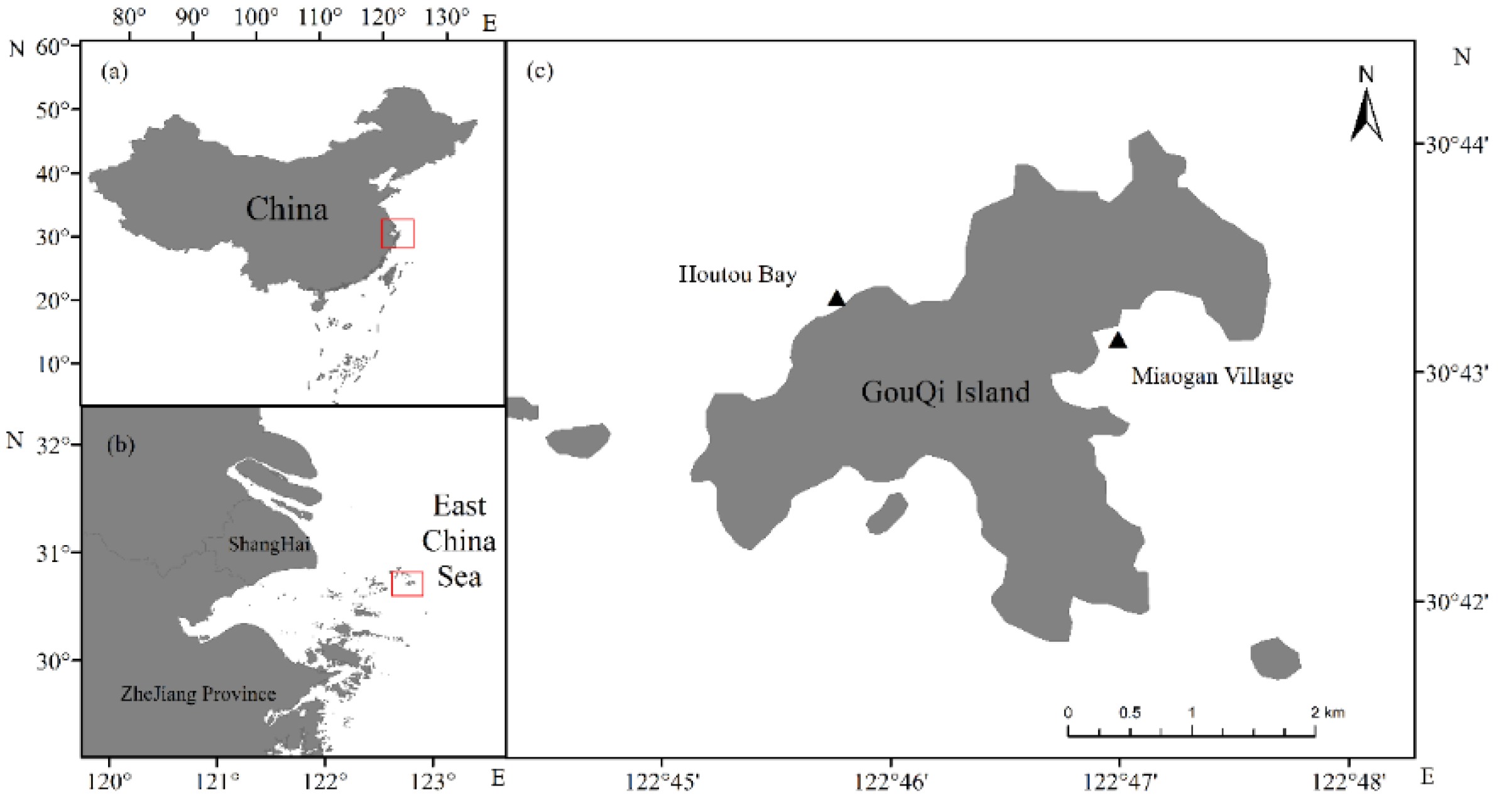

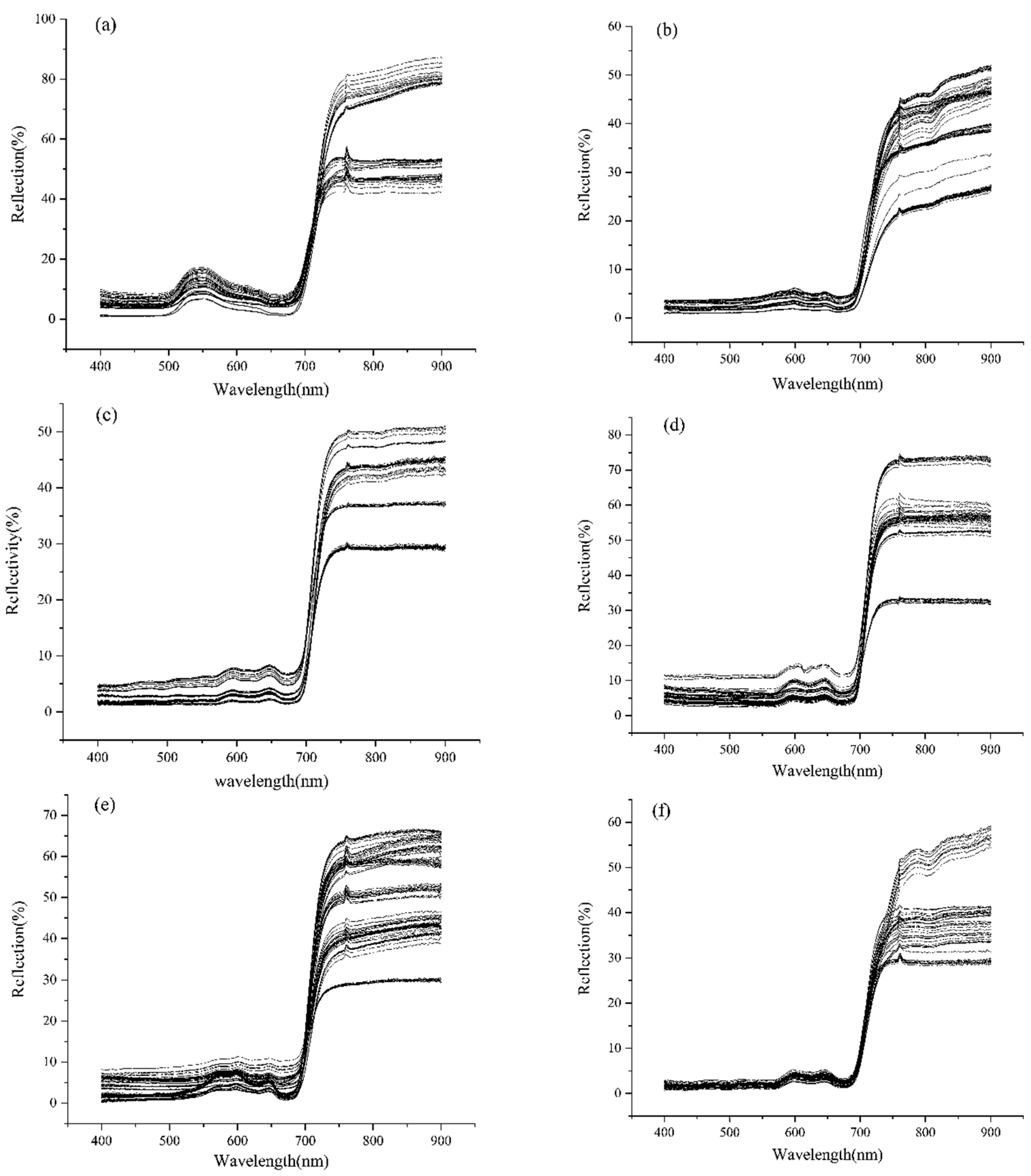

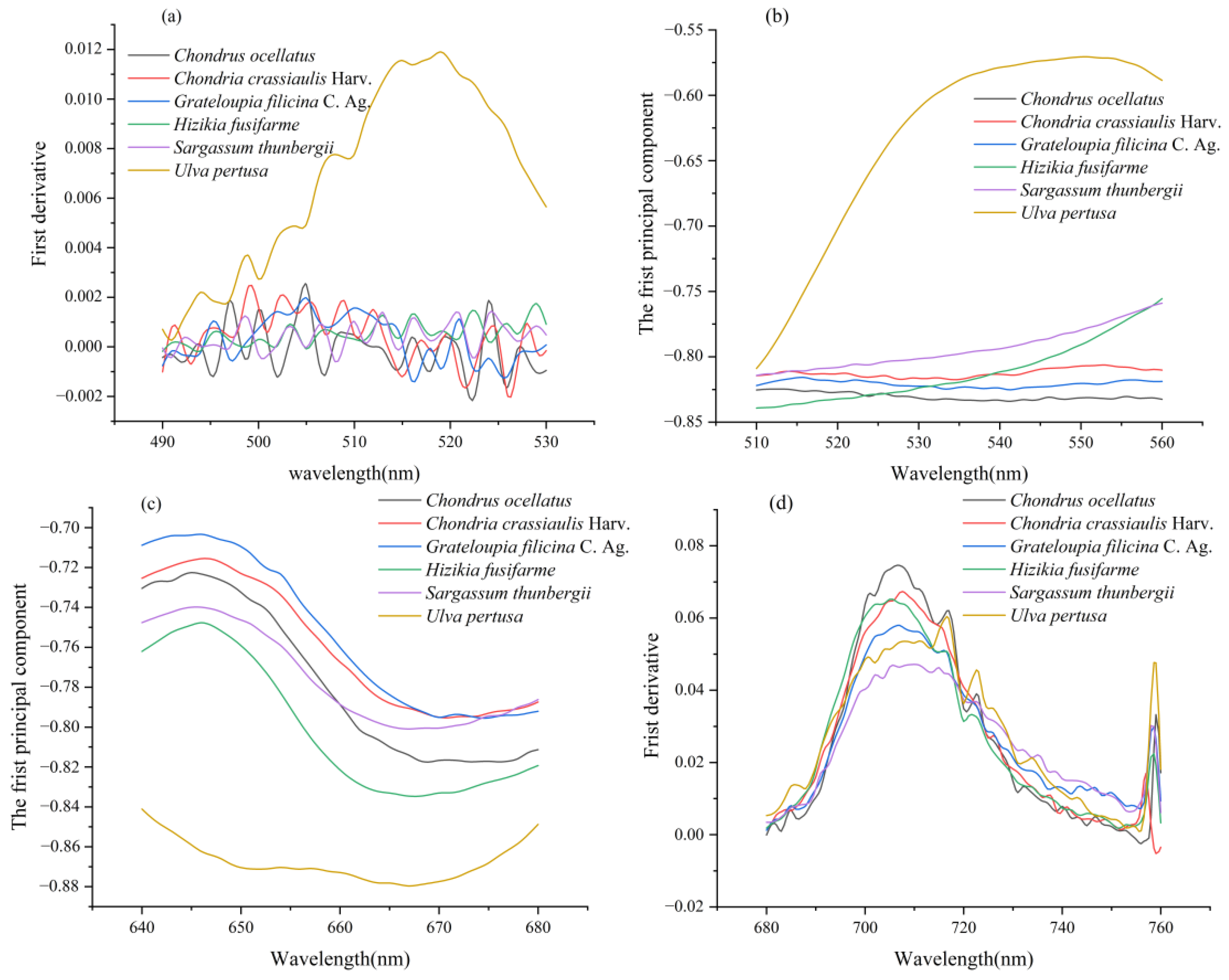
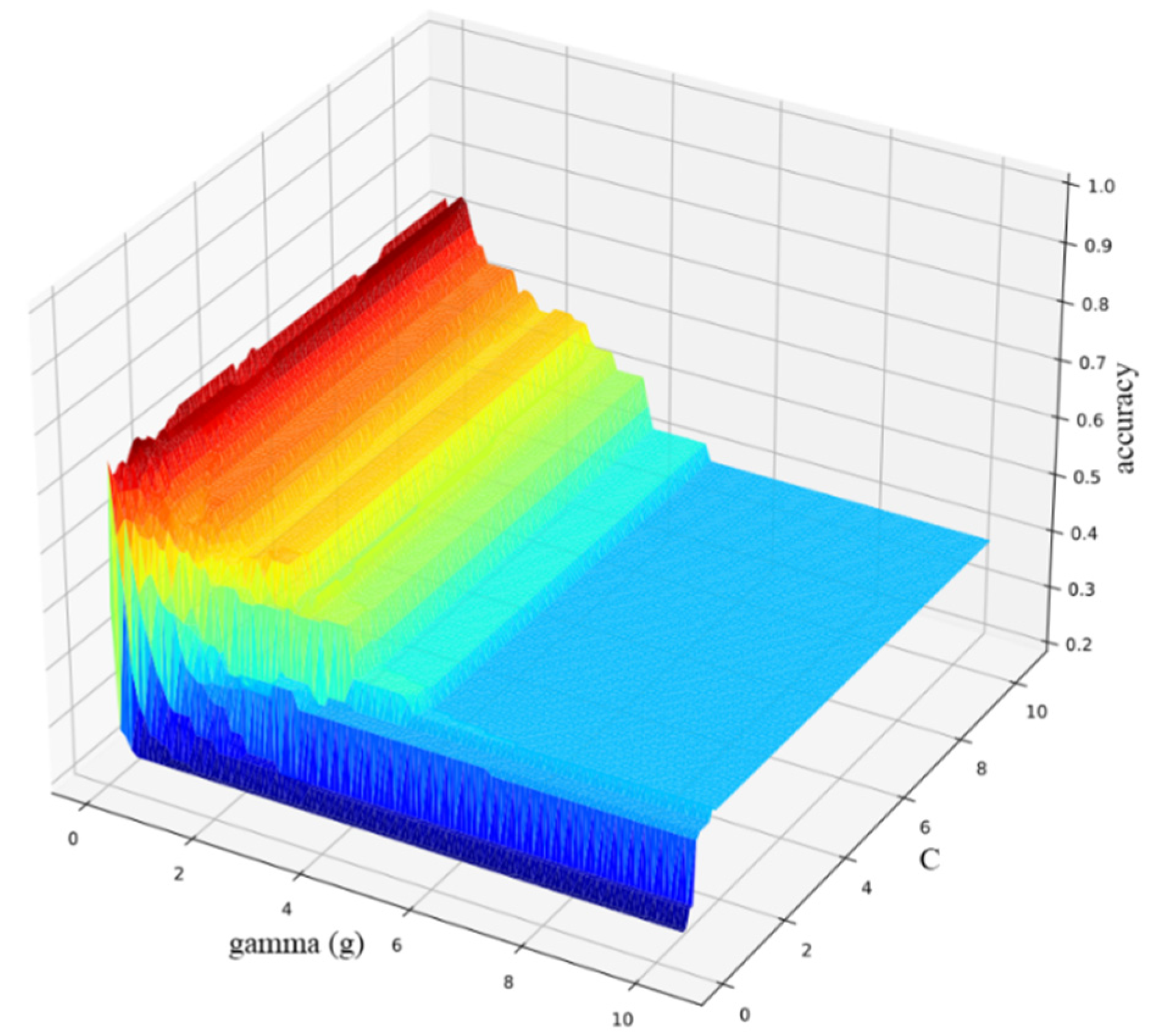
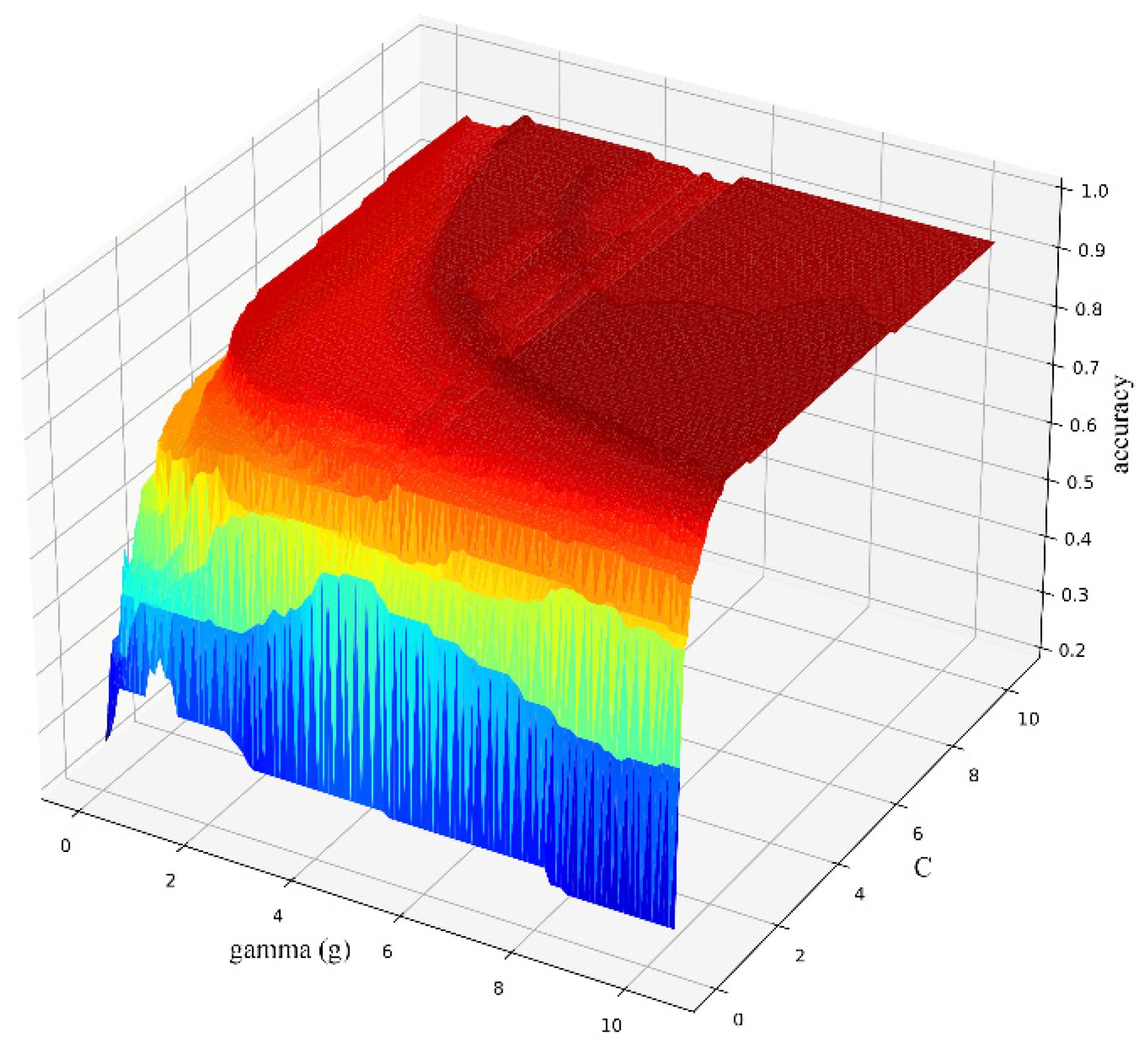

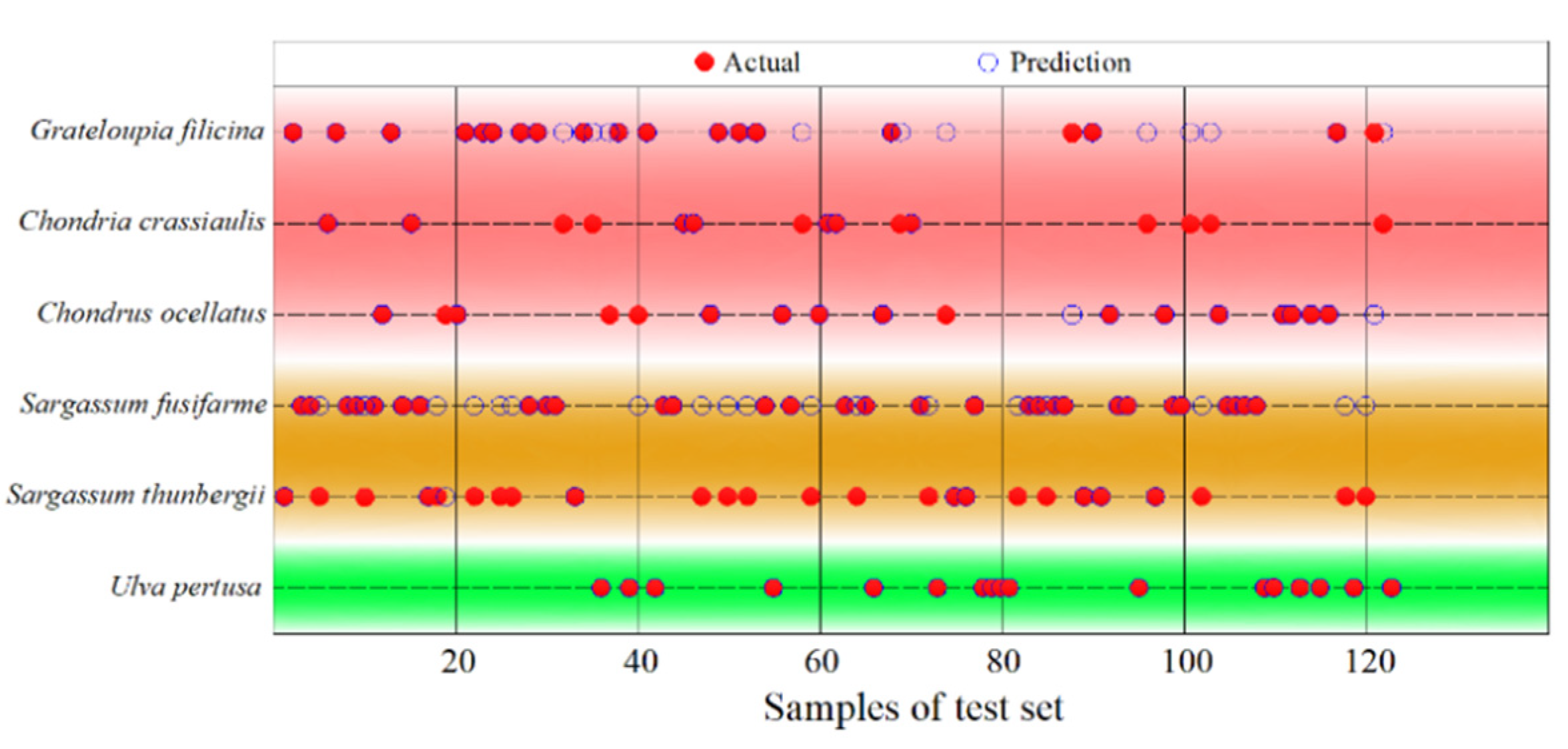

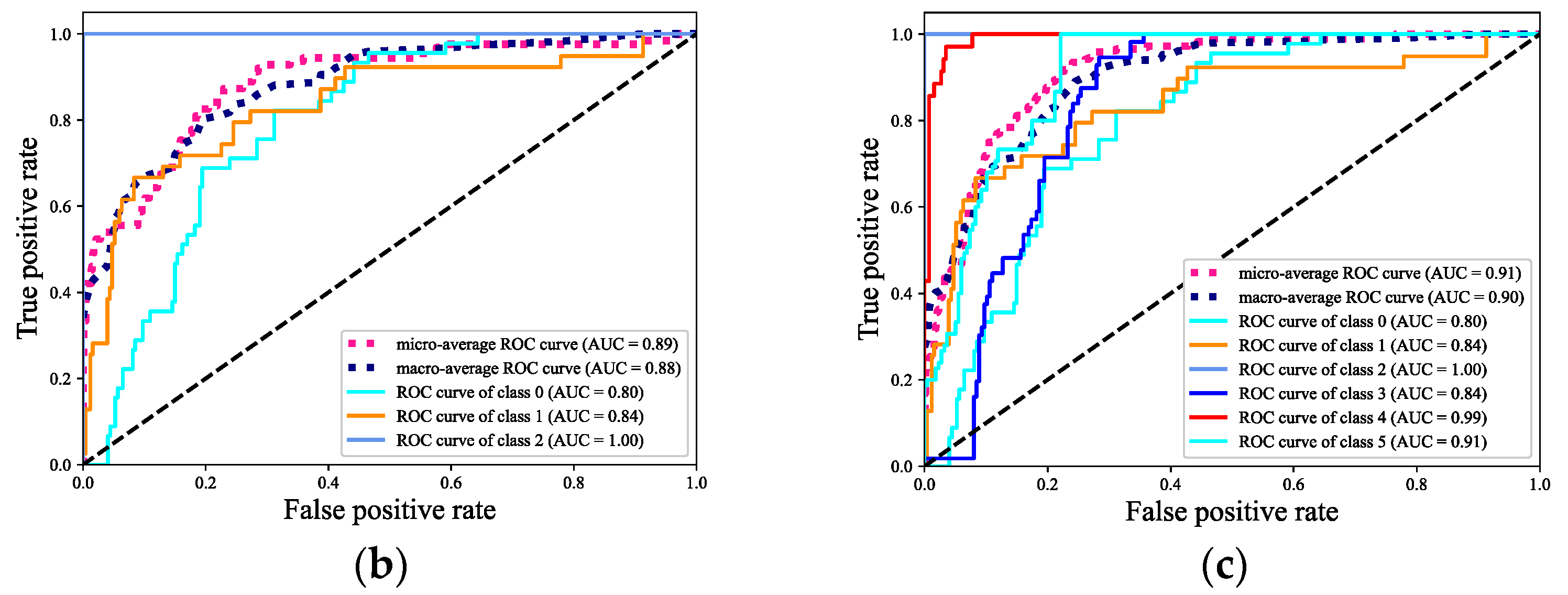
| Variables Types | Variables | Symbol | Definition | Reference |
|---|---|---|---|---|
| Location variables | Green peak amplitude | Rg | Maximum reflectivity of 510–560 nm in green light range | Minglu, T., 2016 |
| Green peak location | Lg | Wavelength of green peak in the green range of 510–560 nm | Fuqi, Y., 2012 | |
| Red valley amplitude | Rr | Maximum reflectivity of 640–680 nm in red light range | Fuqi, Y., 2012 | |
| Red valley location | Lr | Wavelength corresponding to red valley at 640–680 nm in red light range | Fuqi, Y., 2012 | |
| Red edge amplitude | Vre | Maximum value of first order differential of red edge at 680–760 nm | Xiaokang, Y., 2021 | |
| Red edge location | Lre | Wavelength corresponding to red edge amplitude | Cho, M. A., 2006 | |
| Blue edge amplitude | Vbe | First order differential maximum of blue edge at 490–530 nm | Xiaokang, Y., 2021 | |
| Blue edge location | Lbe | Band length corresponding to blue edge amplitude | Yuna, W., 2021 | |
| Area variables | Red edge area | Are | Sum of first order differential values in the range of red edge | Xiaokang, Y., 2021 |
| Blue edge area | Abe | Sum of first order differential values in the range of blue edge | Xiaokang, Y., 2021 | |
| Vegetation index variables | Rg/Rr | RVI (Rg, Rr) | Amplitude ratio of green peak to red valley | Minglu, T., 2016 |
| Are/Abe | RVI (Are, Abe) | Area ratio of red edge to blue edge | Xiaokang, Y., 2021 | |
| (Rg − Rr)/(Rg + Rr) | NDVI (Rg, Rr) | Normalized ratio of green peak to red valley amplitude | Minglu, T., 2016 | |
| (Are − Abe)/(Are + Abe) | NDVI (Are, Abe) | Normalized ratio of red edge area to blue edge area | Xiaokang, Y., 2021 |
| Spectral Variables | Number of “*” in Appendix A, Table A2 |
|---|---|
| NDVI (Rg, Rr) | 14 |
| RVI (Rg, Rr) | 14 |
| Vre | 14 |
| Abe | 13 |
| Rg | 13 |
| Lre | 12 |
| Lg | 12 |
| Lr | 11 |
| Rr | 11 |
| Lbe | 11 |
| NDVI (Are, Abe) | 11 |
| Are | 10 |
| Vbe | 9 |
| RVI (Are, Abe) | 7 |
| Rejected Variables | Variable Quantity | Accuracy (%) |
|---|---|---|
| ---- | 14 | 40.89 |
| RVI (Are, Abe), Vbe, Are, NDVI (Are, Abe) | 10 | 68.34 |
| RVI (Are, Abe), Vbe, Are, NDVI (Are, Abe), Lbe | 9 | 66.02 |
| RVI (Are, Abe), Vbe, Are, NDVI (Are, Abe), Lbe, Rr | 8 | 74.99 |
| RVI (Are, Abe), Vbe, Are, NDVI (Are, Abe), Lbe, Rr, Lr | 7 | 72.03 |
| RVI (Are, Abe), Vbe, Are, NDVI (Are, Abe), Lbe, Rr, Lr, Lg | 6 | 64.68 |
Publisher’s Note: MDPI stays neutral with regard to jurisdictional claims in published maps and institutional affiliations. |
© 2022 by the authors. Licensee MDPI, Basel, Switzerland. This article is an open access article distributed under the terms and conditions of the Creative Commons Attribution (CC BY) license (https://creativecommons.org/licenses/by/4.0/).
Share and Cite
Chen, J.; Li, X.; Wang, K.; Zhang, S.; Li, J.; Zhang, J.; Gao, W. Variable Optimization of Seaweed Spectral Response Characteristics and Species Identification in Gouqi Island. Sensors 2022, 22, 4656. https://doi.org/10.3390/s22134656
Chen J, Li X, Wang K, Zhang S, Li J, Zhang J, Gao W. Variable Optimization of Seaweed Spectral Response Characteristics and Species Identification in Gouqi Island. Sensors. 2022; 22(13):4656. https://doi.org/10.3390/s22134656
Chicago/Turabian StyleChen, Jianqu, Xunmeng Li, Kai Wang, Shouyu Zhang, Jun Li, Jian Zhang, and Weicheng Gao. 2022. "Variable Optimization of Seaweed Spectral Response Characteristics and Species Identification in Gouqi Island" Sensors 22, no. 13: 4656. https://doi.org/10.3390/s22134656
APA StyleChen, J., Li, X., Wang, K., Zhang, S., Li, J., Zhang, J., & Gao, W. (2022). Variable Optimization of Seaweed Spectral Response Characteristics and Species Identification in Gouqi Island. Sensors, 22(13), 4656. https://doi.org/10.3390/s22134656





